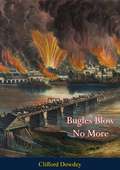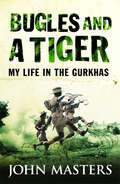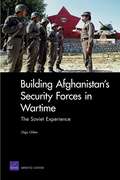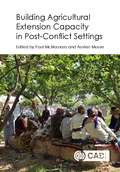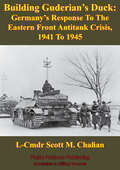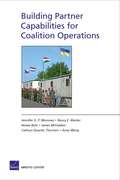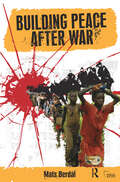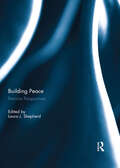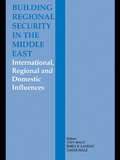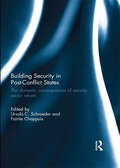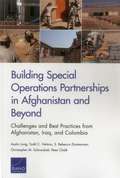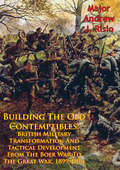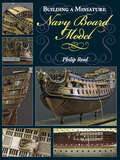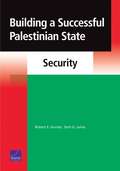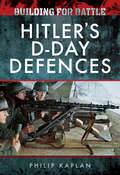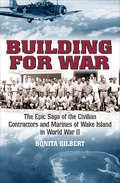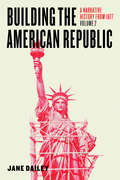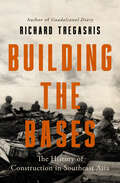- Table View
- List View
Bugles Blow No More
by Clifford Dowdey“YOU WON’T FORGET ME…”Mildred knew that Brose was right. She would never forget him—his hard, black eyes—his manner of calm assurance. Ever since their first meeting so long ago, she had thought of him unceasingly. He was different from any man she had ever met. There was something about him that was evil—and yet she had to have him…Brose Kirby came up through the ranks. He was a man born to make a name. Tough, driving—a man who would stop at nothing to get what he wanted. And he wanted Mildred Wade. But she was the daughter of one of Richmond’s greatest families—and Brose—Brose was scum…This is one of the truly great novels of the Civil War. Powerful, vivid—panoramic in scope, it is a brilliant picture of the scorched and bloody days that helped to form today’s America.
Bugles and a Tiger: My life in the Gurkhas (W&N Military)
by John MastersThe first of John Master's evocative memoirs about life in the Gurkhas in India on the cusp of WWIIJohn Masters was a soldier before he became a bestselling novelist. He went to Sandhurst in 1933 at the age of eighteen and was commissioned into the 4th Gurkha Rifles in time to take part in some of the last campaigns on the turbulent north-west frontier of India.John Masters joined a Gurhka regiment on receiving his commission, and his depiction of garrison life and campaigning on the North-West Frontier has never been surpassed. BUGLES AND A TIGER is a matchless evocation of the British Army in India on the eve of the Second World War. Still very much the army depicted by Kipling, it stands on the threshold of a war that will transform the world. This book is the first of three volumes of autobiography that touched a chord in the post-war world.
Builders and Fighters: U.S. Army Engineers in World War II
by Barry W. FowleThe Corps of Engineers played an important role in winning World War II. Its work included building and repairing roads, bridges, and airfields; laying and clearing minefields; establishing and destroying obstacles; constructing training camps and other support facilities; building the Pentagon; and providing facilities for the development of the atomic bomb. In addition to their construction work, engineers engaged in combat with the enemy in the Battle of the Bulge, on the Ledo Road in Burma, in the mountains of Italy, and at numerous other locations. Certainly one of the highlights of Corps activity during World War II was the construction of the 1,685-mile Alaska Highway, cared out of the Canadian and Alaskan wilderness. “Builders and Fighters” is a series of essays on some of the hectic engineer activity during World War II. Veterans of that war should read this book and point with pride to their accomplishments. In it, today’s engineers will find further reasons to be proud of their heritage.
Building Afghanistan's Security Forces in Wartime: The Soviet Experience
by Olga OlikerSecurity force assistance is central to the counterinsurgency campaign of U.S. and coalition forces in Afghanistan. The outcome will hinge on the effectiveness of the assistance provided to the Afghan National Army, Afghan National Police, and other security forces. This report provides an overview of Soviet efforts to improve and facilitate the training and development of Afghan security forces.
Building Agricultural Extension Capacity in Post-Conflict Settings
by Paul E. Mcnamara Austen MooreThis book (a) investigates the experiences and issues involved with extension systems in post-conflict settings, (b) evaluates the impact of different extension policy approaches and practice in such settings, and (c) identifies the key elements needed to effectively rebuild agricultural extension systems and programs in post-conflict contexts. The chapters contain country-specific case studies that provide a descriptive account but also analyze strategies, successes and failures, and lessons learned. A synthesis chapter provides comparative analysis of insights across post-conflict settings. Overall, the book serves as a collective volume for use by governments, practitioners, and academics in extension policy-making and programming, and contributes to post-conflict, political science, and agricultural extension literatures.
Building Defence Capacity in Europe: An Assessment
European states have embarked on the long road to rebuilding their defence capabilities. After decades of underinvestment in the armed forces and the defence-industrial base, the challenges are significant. However, since Russia’s full-scale invasion of Ukraine in February 2022, NATO countries have committed to ambitious readiness and war-fighting plans. Against this background, this IISS Strategic Dossier evaluates key areas for building defence capabilities in Europe, including recent developments in the transatlantic defence ecosystem, defence spending, defence-industrial production capacity, building more resilient forces and improving supply-chain security. Europe’s ability to meet its NATO commitments will depend on the degree to which it manages to address these important issues. The analysis covers the trend of increased defence spending by most European NATO members and the growth in defence production capacity in important capability areas. It also provides insights into the ways in which various European countries have sought to address their recruitment and retention challenges. The volume discusses other ongoing challenges, including uncertainty over the long-term affordability, sustainability and effectiveness of increased defence spending in Europe. In addition, the dossier highlights the requirement for long-term government investment, as well as firm demand signals, in order to sustain increased defence production. This IISS Strategic Dossier was produced in the context of the IISS Prague Defence Summit (PDS) 2024, which has been supported by the government of the Czech Republic.
Building Dictatorships under Axis Rule: War, Military Occupation and Political Regimes (Routledge Studies in Fascism and the Far Right)
by António Costa Pinto Goffredo AdinolfiThis book offers a broad comparative perspective on regime building under Axis rule during the Second World War, exploring case studies in Europe and Asia.Military occupation represents the highest degree of political, social and economic control over an occupied state and its society. This collective book analyses how the three poles of Axis rule—Nazi Germany, Italian Fascism and Authoritarian Japan—lead the dynamics of institution-building of political regimes of occupation under their direct or indirect control.The contributions examine how the ideological, political and economic relationship between the occupying forces and different segments of national and local elites were present in the institutional crafting of new regimes. Military occupation opened a window of opportunity for the takeover of power by different segments of these authoritarian elites and the tension and forced pacts between different projects of institutionalization of dictatorships were a clear sign of this dynamic process. In this context, the debates and the praxis of the construction of new dictatorial political systems are analysed, looking to identify the design of their institutions, the segments of the political elites that hegemonize them, the diffusion and promotion models present, and the attitudes of the Axis powers before them.This volume is ideal for all those interested in the study of War, Dictatorships and the global history and politics of Fascism.
Building Guderian’s Duck: Germany’s Response To The Eastern Front Antitank Crisis, 1941 To 1945
by L-Cmdr Scott M. ChafianThe appearance of the T-34 in 1941 caused a crisis for German antitank forces. Existing antitank guns were nearly impotent against the new Russian tank, while antiaircraft and artillery pieces, though successful when pressed into action, were insufficiently mobile to accompany mechanized forces. The German Army Ordnance Office, the Heereswaffenamt, was responsible for development of new weapons and would be responsible for countering the threat of Russian armor. The Heereswaffenamt would need to not only counter the T-34, but also do so in an environment of shifting political relationships and with an increasingly stressed industrial system. Utilizing lessons from the bitterly contested battlefields of western Russia, the Heereswaffenamt developed a tank-destroyer, the Jagdpazer IV, using the existing chassis of the Panzer IV tank, and the guns of both the Panzer IV and Panther tanks. The Jagdpanzer IV, known by its crews as Guderian's Duck, proved to be a capable tank killer against both the T-34 threat of 1941 and 1942, as well as the improved versions of 1943 and 1944.
Building Partner Capabilities for Coalition Operations
by Jennifer D. Moroney Cathryn Quantic Thurston James Mcfadden Nancy E. Blacker Renee BuhrOngoing operations and emerging mission requirements place a heavy burden on Army resources, resulting in capability gaps that the Army is unable to fill by itself. One solution is to build the appropriate capabilities in allies and partner armies through focused security cooperation. To do this, Army planners need a more comprehensive understanding of the capability gaps and a process for matching those gaps with candidate partner armies.
Building Peace After War (Adelphi Ser.)
by Mats BerdalThe widespread practice of intervention by outside actors aimed at building ‘sustainable peace within societies ravaged by war has been a striking feature of the post-Cold War era. But, at a time when more peacekeepers are deployed around the world than at any other point in history, is the international will to intervene beginning to wane? And how capable are the systems that exist for planning and deployingpeacebuilding missions of fulfilling the increasingly complex tasks set for them? In Building Peace After War, Mats Berdal addresses these and other crucial questions, examining the record of interventions from Cambodia in the early 1990s to contemporary efforts in Afghanistan and the Democratic Republic of the Congo. The book analyses the nature of the modern peacebuilding environment, in particular the historical and psychological conditions that shape it, and addresses the key tasks faced by outside forces in the early and criticalpost-conflict phase of an intervention. In doing so, it asks searching questions about the role of military force in support of peacebuilding, and the vital importance of legitimacy to any intervention. Berdal also looks critically at the ways in which governments and international organisations, particularly the UN, have responded to these many challenges. He highlights the pivotal role of politics in planning peacebuilding operations, and offers some sober reflections on the future prospects for post-conflict intervention.
Building Peace: Feminist Perspectives
by Laura J. ShepherdMoving seamlessly from the global to the local, from the politics of institutions to the theoretical apparatus through which we analyse peace and security governance, the contributions to this volume draw attention to the operations of gendered power in peacebuilding across diverse contexts and explore the possibilities of gender-sensitive, sustainable peace. The authors have wide-ranging expertise in gendered analysis of the peacebuilding practices of international and national organisation, detailed and complex qualitative analysis of the gendered politics of peacebuilding in specific country contexts, and feminist analysis of the tools we use to think with when approaching contemporary debates about peacebuilding. The volume thus serves not only as a useful marker of the development of feminist encounters with peacebuilding but also as a foundation for future scholarship in this area. This book was originally published as a special issue of the journal Peacebuilding.
Building Regional Security in the Middle East: Domestic, Regional and International Influences
by Zeev Maoz Emily B. Landau Tamar MalzDiscussions on regional security were initiated in the Middle East in 1992, as part of the Middle East peace process. The collapse of the Oslo process and other regional developments in the latter half of the 1990s have diminished hopes that the initial gains made in this direction might further develop, as violence has again become the primary mode of effecting political changes in the region. On the backdrop of this somewhat dismal current reality in the Middle East the rationale for this volume is that research into regional security structures should nevertheless be pursued. When looking at the long term process of creating regional security, setbacks are not unlikely. The articles that make up this collection focus on the problems that have been encountered, and possible directions for getting regional efforts back on track.A special issue of the Journal of Strategic Studies
Building Security in Africa: An Evaluation of U.S. Security Sector Assistance in Africa from the Cold War to the Present
by Stephen Watts; Trevor Johnston; Matthew Lane; Sean Mann; Michael J. McNerney; Andrew Brooks;A RAND Corporation study used statistical models to evaluate the impact that U.S.-provided SSA has had on political violence in Africa--in particular, the incidence of civil wars and insurgencies, terrorist attacks, and state repression.
Building Security in Post-Conflict States: The Domestic Consequences of Security Sector Reform
by Ursula C. Schroeder and Fairlie ChappuisSupport for security and justice institutions has become a crucial instrument of international engagement in fragile and conflict-affected states. In attempts to shore up security as a precondition for sustainable peace, international actors have become deeply engaged in reforming the security agencies and security governance institutions of states emerging from conflict. But despite their increasing importance in the field of international peace- and state-building, security sector reform (SSR) interventions remain both highly political and deeply contentious processes. Expanding on this theme, this edited volume identifies new directions in research on the domestic consequences of external support to security sector reform. Both empirically and theoretically, the focus lies on the so far neglected role of domestic actors, interests and political power constellations in recipient states. Based on a wide range of empirical cases, the volume discusses how the often conflictual and asymmetric encounters between external and domestic actors with divergent interests and perceptions affect the consequences of international interventions. By taking into account the plurality of state and non-state security actors and institutions beyond classical models of Weberian statehood, the contributions make the case for engaging more closely with the complexity of the domestic security governance configurations that can result from external engagement in the field of security sector reform.This book was published as a special issue of International Peacekeeping.
Building Security in the Persian Gulf
by Robert E. HunterThe United States must determine how best to promote long-term security and stability in the Persian Gulf region while seeking to reduce the risks and costs imposed by its role as a permanent regional power. The author analyzes Iraq's future, the role of Iran, asymmetric threats, regional reassurance, regional tensions, and the roles of other external actors. He then sets out criteria and requirements for a new regional security structure.
Building Special Operations Partnerships in Afghanistan and Beyond: Challenges and Best Practices from Afghanistan, Iraq, and Colombia
by Peter Chalk Austin Long Todd C. Helmus S. Rebecca Zimmerman Christopher M. SchnaubeltBuilding the capacity of Afghan special operations forces (SOF) is a key goal of the United States and its coalition partners. This report summarizes key partnering practices and presents findings from SOF partnership case studies in Afghanistan, Iraq, and Colombia. The goal is to identify best practices to benefit the development of Afghan SOF, as well as for special operations partnerships beyond Afghanistan.
Building The Old Contemptibles: British Military Transformation And Tactical Development From The Boer War To The Great War, 1899-1914
by Major Andrew J. RisioImpressed with the tactical lessons of the Boer War, the British Army reformed its doctrine and training from 1899 to 1914, deploying a combat ready force, the "Old Contemptibles" of the British Expeditionary Force (BEF) in 1914. Because of these changes, the BEF played a crucial role in Belgium and France in 1914. The lessons of the Boer War guided the British Army and its interwar reforms. The doctrine and training developed from 1902-1914 was a significant improvement over the pre-Boer War British colonial warfare tactics. With Haldane's organizational reforms and Robert's new doctrine, the British Army built the Old Contemptibles of the BEF. The battles of 1914 showed the BEF was the equal of any European contemporary in quality of its tactics and doctrine. The comparison of the BEF to the other combatants in 1914 does not stand in stark contrast. The BEF performed well but no better or worse than comparable German or French units did. What does stand in stark contrast is the BEF in 1914 when compared with the expedition to South Africa in 1899. The years of reform between these two expeditions were truly a crucible that built the Old Contemptibles.
Building a Miniature Navy Board Model
by Philip ReedThe expert model maker takes readers through every stage of building a miniature navy board model in this fully illustrated step-by-step guide. In this clear and detailed volume, Phil Reed tackles the ultimate expression of the ship model maker's art: The Navy Board model. These early eighteenth-century works of art are well represented in major maritime museums and private collections. Here, Reed takes on the construction of a miniature 1/192 scale model of the Royal George of 1715, covering all the conventions of Navy Board framing and planking. With nearly 400 photographs, each accompanied by explanatory text, Building a Miniature Navy Board Model takes readers through every step of the process. Methods of hull and deck framing, internal and external planking, and the construction of the complex stern are all covered. The rendering of the multitude of decorative carvings on the figurehead, stern and broadside is also demonstrated. At the end of the book there is a short section showing his model of The Syren, which demonstrates how the techniques used to frame Royal George could be adapted for ships of a later date, using single and double frames closer to full-size practice
Building a Nazi Europe
by Gutmann Martin R.In a compelling new study, Gutmann offers an in-depth examination of the Swedish, Swiss and Danish men who worked and fought for the SS, during the Second World War. Dispelling a host of myths regarding foreign collaboration with Hitler's regime, it reveals how these men were highly motivated to affect a National Socialist revolution across North-Western or 'Germanic' Europe. Working behind Berlin desks, they played a pivotal part in shaping the Nazi New Order and actively participated in the regime's brutal atrocities on the Eastern Front and on the streets of Western Europe. The book argues that these men became a focal point for infighting in the regime regarding the role of non-Germans in National Socialism. Building a Nazi Europe sheds new light on historical conceptions of fascism, collaboration, transnational history and the holocaust.
Building a Successful Palestinian State: Security
by Seth G. Jones Robert E. HunterThroughout the history of Arab-Israeli peace negotiations, security has been the most important-and most challenging-issue for Palestinians, Israelis, and their neighbors. This study examines key external security issues regarding the construction of a Palestinian state. Its proposals include a NATO-led international peace-enabling force and Israeli-Palestinian confidence-building measures.
Building for Battle: Hitler's D-Day Defences
by Philip KaplanFollowing nearly two years of planning and exacting preparation, Operation Overlord, the Allied invasion of the Nazi-dominated European continent, was mounted in the early hours of 6th June, 1944. It was to be a pivotal event leading to the end of the Second World War and victory for the Allied forces. The invasion itself was centred on the largest amphibious landing operation in history. It involved 7000 naval vessels, 3000 aircraft, 17000 American and British paratroopers and thousands of additional military personnel. What awaited the Allied landing forces—many of them suffering the effects of sea sickness when they were delivered into the surf of the five main landing beaches on the Normandy coast of France—were key elements in the formidable defences of Hitlers vaunted Atlantic Wall. The Wall was a 2500-mile chain of various types of fortifications stretching from the North Cape to the Bay of Biscay. That portion of the German defences between Caen to the east and Cherbourg to the west was particularly menacing, due largely to the planning and implementations of Feldmarschall Erwin Rommel, appointed by Hitler to take charge of the Atlantic Wall defences.D-Day Defences revisits many of the locations within the five-beach landing area of the invasion forces, focusing on the various aspects of the German fortifications, the types of defensive systems employed against the American, British and Canadian invaders, and the results experienced by both invaders and defenders in the Allied struggle to gain and hold possession of that pathway to Berlin.
Building for Battle: U-boat Pens Of The Atlantic Battle
by Philip KaplanThe only thing that ever really frightened me during the war was the U-boat peril - Prime Minister Winston Churchill. Churchill, as a former First Lord of the Admiralty, was well versed in the importance of Britain protecting itself at sea. In the opening years of the Second World War, Germanys U-boat (submarine) fleet was tasked with attacking and destroying the supply ships that Britain depended upon for its survival.The U-boats were under the command of Grand Admiral Karl Doenitz who, for much of the war, effectively guided that strategy. There was a very real possibility that the British people would starve if the U-boats succeeded in their campaign. When France fell to the German forces in 1940, Hitlers Ubootwaffe gained a significant asset in five important ports along the Brittany coast - Brest, Lorient, St. Nazaire, La Palace and Bordeaux. The use of these ports put Germanys submarine force hundreds of miles closer to the action in the North Atlantic, the routes of the Allied supply convoys which were operating mainly between Halifax, Nova Scotia and various English port cities. This afforded the U-boats several more days at sea on their deadly patrols than was possible while they had been based in Germany and German-occupied Norway.In this new publication from Philip Kaplan, the massive bunkers or pens constructed in Brittany by the laborers of the German Organisation Todt are revisited. These giant structures, some of which sheltered more than a dozen submarines at a time, still exist because they were built with concrete ceilings more than three meters thick. With equally impressive supporting walls, they suffered relatively little damage in the wartime bombing raids of the Royal Air Force and the US Eighth Army Air Force. Illustrated with more than 150 rare and compelling photo images, this book is a richly rewarding journey back across time to some of the most intriguing and electrifying sites from the war years. The story of the pen shelters and their part in that war is both fascinating and enduring.
Building for War: The Epic Saga of the Civilian Contractors and Marines of Wake Island in World War II
by Bonita GilbertThe story of the Americans who came under attack five hours after Pearl Harbor was hit: &“Intriguing, informative, gripping, and at times very moving&” (Naval Historical Foundation). This intimately researched work tells the story of the thousand-plus Depression-era civilian contractors who came to Wake Island, a remote Pacific atoll, in 1941 to build an air station for the US Navy—charting the contractors&’ hard-won progress as they scramble to build the naval base, as well as runways for US Army Air Corps B-17 Flying Fortresses, while war clouds gather over the Pacific. Five hours after their attack on Pearl Harbor, the Japanese struck Wake Island, which was now isolated from assistance. The undermanned Marine Corps garrison, augmented by civilian-contractor volunteers, fought back against repeated enemy attacks, at one point thwarting a massive landing assault. The atoll was under siege for two weeks as its defenders continued to hope for the US Navy to come to their rescue. Finally succumbing to an overwhelming amphibious attack, the surviving Americans, military and civilian, were taken prisoner. While most were shipped off to Japanese POW camps for slave labor, a number of the civilians were retained as workers on occupied Wake. Later in the war, the last ninety-eight Americans were brutally massacred by their captors. The civilian contractors who had risked distance and danger for well-paying jobs ended up paying a steep price: their freedom and, for many, their lives. Written by the daughter and granddaughter of civilians who served on Wake Island, Building for War sheds new light on why the United States was taken by surprise in December 1941, and shines a spotlight on the little-known, virtually forgotten story of a group of civilian workers and their families whose lives were forever changed by the events on this tiny atoll.
Building the American Republic, Volume 2: A Narrative History from 1877
by Jane DaileyBuilding the American Republic combines centuries of perspectives and voices into a fluid narrative of the United States. Throughout their respective volumes, Harry L. Watson and Jane Dailey take care to integrate varied scholarly perspectives and work to engage a diverse readership by addressing what we all share: membership in a democratic republic, with joint claims on its self-governing tradition. It will be one of the first peer-reviewed American history textbooks to be offered completely free in digital form. Visit buildingtheamericanrepublic.org for more information. The American nation came apart in a violent civil war less than a century after ratification of the Constitution. When it was reborn five years later, both the republic and its Constitution were transformed. Volume 2 opens as America struggles to regain its footing, reeling from a presidential assassination and facing massive economic growth, rapid demographic change, and combustive politics. The next century and a half saw the United States enter and then dominate the world stage, even as the country struggled to live up to its own principles of liberty, justice, and equality. Volume 2 of Building the American Republic takes the reader from the Gilded Age to the present, as the nation becomes an imperial power, rethinks the Constitution, witnesses the rise of powerful new technologies, and navigates an always-shifting cultural landscape shaped by an increasingly diverse population. Ending with the 2016 election, this volume provides a needed reminder that the future of the American republic depends on a citizenry that understands—and can learn from—its history.
Building the Bases: The History of Construction in Southeast Asia
by Richard TregaskisA detailed account of the civil engineering work done to assist US forces during the Vietnam War by the New York Times–bestselling author of Vietnam Diary. To fuel their efforts in the Vietnam War, the US armed forces needed reliable infrastructure. For a modern military machine to function properly in a less developed region, a massive construction effort was required. Roads, bridges, ports, airfields, hospitals, and more were needed, and the results helped propel the nation into the modern age. In Building the Bases, veteran war correspondent Richard Tregaskis documents one of the largest wartime construction undertakings in history, a feat accomplished by the US Navy Seabees and other military and American civilian engineers from 1962 to 1972. Using photos, maps, and charts, as well as extensive travel research, Tregaskis looks at every major piece of infrastructure built for the war effort. Through the backdrop of battles and political intrigues, he weaves a compelling human-interest story of courage and hard work.First published in 1975.
